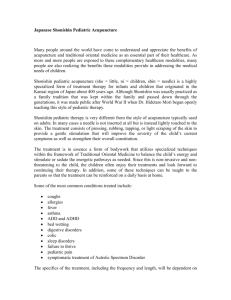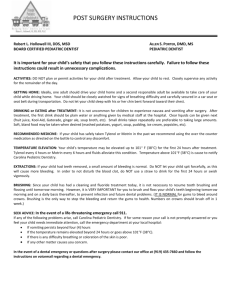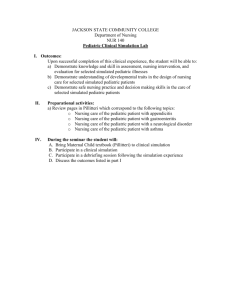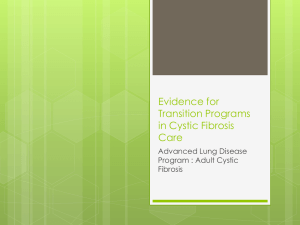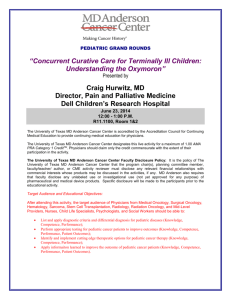Section on Pediatrics – Research Agenda
advertisement
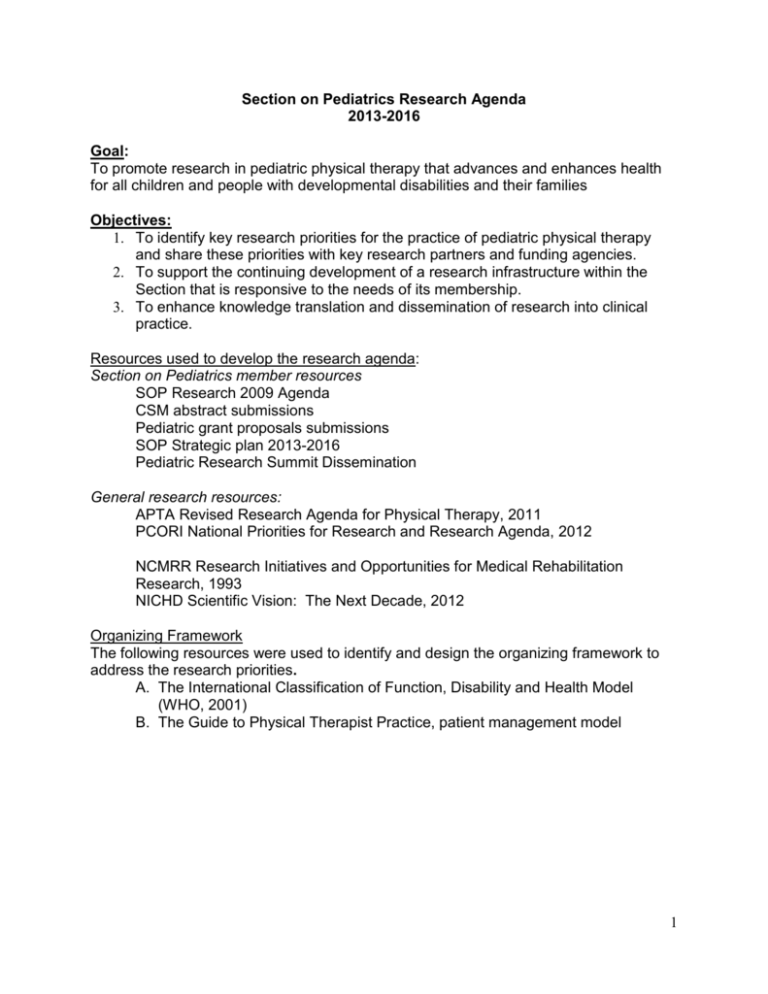
Section on Pediatrics Research Agenda 2013-2016 Goal: To promote research in pediatric physical therapy that advances and enhances health for all children and people with developmental disabilities and their families Objectives: 1. To identify key research priorities for the practice of pediatric physical therapy and share these priorities with key research partners and funding agencies. 2. To support the continuing development of a research infrastructure within the Section that is responsive to the needs of its membership. 3. To enhance knowledge translation and dissemination of research into clinical practice. Resources used to develop the research agenda: Section on Pediatrics member resources SOP Research 2009 Agenda CSM abstract submissions Pediatric grant proposals submissions SOP Strategic plan 2013-2016 Pediatric Research Summit Dissemination General research resources: APTA Revised Research Agenda for Physical Therapy, 2011 PCORI National Priorities for Research and Research Agenda, 2012 NCMRR Research Initiatives and Opportunities for Medical Rehabilitation Research, 1993 NICHD Scientific Vision: The Next Decade, 2012 Organizing Framework The following resources were used to identify and design the organizing framework to address the research priorities. A. The International Classification of Function, Disability and Health Model (WHO, 2001) B. The Guide to Physical Therapist Practice, patient management model 1 Objective 1. To identify key research priorities for the practice of pediatric physical therapy and share these priorities with key research partners and funding agencies Research Priorities (See Table below for examples in each priority) A. Basic Science Research B. Clinical Research C. Epidemiology & Health Services Research D. Measurement Development and Validation E. Knowledge Translation This table includes examples in each priority area, and is not an all-inclusive list. A. Basic Science Research (fundamental theoretical or experimental investigative research to advance knowledge in areas related to pediatric physical therapy; may be human subjects research or cellular or animal models) Body Structure & Function - Explore factors that affect growth and development of muscles, bones, neural networks, and other tissues and systems that contribute to movement - Explore the mechanisms of tissue damage and repair in the musculoskeletal, neuromuscular and cardiorespiratory systems Activity - Describe development in infants and children at risk for movement disorders - Investigate critical/sensitive periods for neuroplasticity and motor development (e.g. in infancy or after neural injury) - Examine relationships between motor development and other domains of child development (e.g. cognitive, social, emotional, and language) Participation - Explore physical activity levels in children with or without movement disorders B. Clinical Research (investigation of etiology, prevention, diagnosis or treatment of movement-related health conditions in children, or in adults with developmental disabilities) Body Structure & Function - Identify impairments in children with or at risk for movement disorders - Explore factors associated with movement-related impairments - Determine the effects of PT interventions on: - skeletal muscle and tendon (e.g. development and modification of muscle architecture, strength, power, muscle and tendon length, activation patterns, and recovery from injury or surgery) - bones and joints (e.g. development and modification of bone density and architecture, infant head shape, alignment of joints, and recovery from injury or surgery) - central and peripheral nervous system (e.g. development and modification of neural pathways and networks, activity-dependent 2 - neural adaptation, regeneration, restoration and compensatory changes after nervous system damage) - the cardiorespiratory system, metabolism and caloric balance (e.g. energy expenditure, aerobic capacity, blood glucose regulation, exercise tolerance, body weight and composition) - pain Improve effects of PT interventions on body structures and functions, by incorporating new scientific discoveries into current interventions, developing new interventions, and/or combining PT interventions with complementary treatments (e.g. medications, regenerative and cellular therapies, brain stimulation) Activity - Identify activity limitations in children with or at risk for movement disorders - Determine the effects of PT interventions on motor development, motor control and motor learning for postural control, locomotion, upper limb movement, and other motor skills, in children with or at risk for movement disorders - Examine relationships between impairments and activity limitations Participation - Identify participation restrictions in children with or at risk for movement disorders - Determine the effects of PT interventions on participation in life situations and on quality of life (e.g. school, recreation, domestic life, interpersonal interactions, family relationships, employment) - Examine the impact of PT interventions, including health promotion, on physical activity in children who are inactive, overweight or obese. - Examine relationships between impairments, activity limitations, participation, and quality of life. Environmental Factors - Investigate the effects of technological advances and equipment on the effectiveness of PT interventions (e.g. robotic devices, interactive gaming systems, virtual reality systems, adaptive exercise equipment) - Investigate the effects of assistive mobility devices, orthotics and prosthetics on gait and other forms of locomotion in children and adults with developmental disabilities - Identify parent, family, home and school characteristics that influence motor development and responsiveness to PT interventions Personal Factors - Identify personal characteristics that influence child development and responsiveness to PT interventions (e.g. motivation, attention, experience, behavior patterns) C. Epidemiology & Health Services Research - Investigate factors that influence health policy and health services for children with movement disorders - Improve the profession’s capacity to conduct child-centered outcomes 3 research by building data infrastructure and by connecting researchers with potential collaborators, mentors, funding agencies, clinicians and consumers. - Identify doses of PT interventions that achieve optimal responses (e.g. timing episodes of care, session frequency, duration, intensity, and content, and recommendations for follow through) - Evaluate service delivery models for pediatric PT, including early intervention, and their effects on child-centered outcomes, family-centered outcomes and cost-effectiveness (e.g. integrative and consultative services, primary-provider model, care coordination, natural environments) - Examine differential outcomes as a function of health disparities (across diagnoses, ages, and transitions) - Examine the incidence, prevalence and natural course of movementrelated health conditions commonly managed by pediatric physical therapists. - Evaluate the extent to which pediatric physical therapist decision making is based on available evidence and/or recommended practice guidelines. - Evaluate the effects of health promotion efforts by pediatric physical therapists on longitudinal trends in child health and development. - Identify factors that contribute to utilization and consumer choice in the selection of pediatric physical therapy services. D. Measurement Development & Validation Body Structure & Function - Develop and refine measurement tools to identify impairments and monitor changes in the musculoskeletal, neuromuscular and cardiorespiratory systems. (e.g. cardiorespiratory fitness measures for children, muscle imaging, brain imaging, brain mapping) - Develop pain assessment tools for children Activity - Develop and refine measurement tools for prediction of developmental outcomes and responsiveness to intervention based on infant motor behavior - Develop and refine measurement tools to identify activity limitations and monitor changes in postural control, locomotion, upper limb movement and other motor skills in children - Examine the value of motion analysis for treatment planning, including selection of PT interventions, orthotics, and surgical procedures, and effects on child-centered outcomes. Participation - Develop and refine measures of participation in life situations for children and for adults with developmental disabilities (e.g. fulfillment of life roles in the home, school, community, workplace) - Develop and refine measures of quality of life in children Other - Determine minimal detectable changes and minimal clinically important 4 differences for measures used in pediatric physical therapy practice and research - Develop a minimum set of measures to evaluate and monitor changes in children from birth to 3 years of age. - Develop and refine systems for classifying children with movement disorders and determining PT diagnoses E. Knowledge Translation - Evaluate the feasibility of a knowledge translation program. - Develop a national system for web based knowledge translation. - Examine the efficacy of a mentoring program to improve knowledge translation. - Examine the efficacy of a knowledge brokers progams to promote knowledge translation in practice. Objective #2. “To support the continuing development of a research infrastructure within the Section that is responsive to the needs of its membership The SOP Research Committee supports the SOP Strategic Plan for 2013 – 2016. Specific goals and strategies from the Strategic Plan that are closely aligned with the Research Committee and the Research Agenda are listed below. Goal 1: Promote the highest standards of practice in pediatric physical therapy A. Explore the role and scope of pediatric physical therapy, and disseminate information. Strategy #1: Develop and disseminate a document on intensity for inpatient physical therapy services.(Practice Committee) The Research Committee acknowledges there is limited evidence on intensity of inpatient PT services and supports the Practice Committee’s efforts by supporting the the development of evidence in this important topic area. Strategy #5: Create clinical practice guidelines (torticollis, DMD, other?) for publication in PPT and posting through Guidelines.gov (Practice Committee) The Research Committee supports development of evidence through the creation of clinical practice guidelines as outlined by the Practice Committee. Goal 2: Advance education and lifelong learning in pediatric physical therapy. A. Promote effective lifelong learning for pediatric PTs and PTAs. Strategy #3: Explore development of a knowledge-broker training program that would utilize a “train the trainer” approach to encourage translation of knowledge into practice. (KT Work Group with Research, Practice, Education) The Research Committee will provide resources as able to support development of knowledge-broker programs utilizing “train the trainer” approaches as indicated by the KT Work Group 5 Goal 3: Advance research and the translation of evidence into pediatric physical therapy practice. A. Advance pediatric physical therapy research. Strategy #1: Submit grant and/or research summit products to Pediatric Physical Therapy, so the information is shared with Section membership. The Research Committee provides resources to grant recipients and Research Summit Subcommittee members to support product submission. B. Improve translation of research to practice. Strategy #1: Explore use of the member survey to guide choice of funded research topics (specific request for proposals, give priority to identified topic areas for planning grants and research summits, etc). Strategy #2: Explore options for members to participate in pediatric physical therapy research (e.g., development of a researcher or clinician registry). The Research Committee 1) Participates in member surveys to identify prevalent topics of interest for Research Summits and Research Summit planning grants. 2) Supports section members’ research development by SOP website information on Research Summit outcomes, grant funding and participants involved. 3) Participates in KT Workgroup activities 4) Increases awareness and accountability for use of research grant funds by posting information about funded grants and project/study activities on the Communities Website for the Section on Pediatrics. This information serves as a researcher registry and provides names of researchers who may serve as mentors. Objective 3. “To enhance knowledge translation and dissemination of research into clinical practice” Recommendations from the Task Force: 1. Research proposals submitted to the Section on Pediatrics Clinical Grants competition should focus on the Research Priorities identified in this agenda unless instructions in an RFP (request for proposal) or RFA (request for application) specifically state otherwise. 2. Best research designs are those that are best matched to the research question or specific aims and hypotheses, the granting agencies’ defined mission and purpose, and available grant funds. The Task Force recommends that grant applicants propose the most appropriate research design to answer their research question or examine their specific aims. 6 3. The Research Agenda is a dynamic document and annual reviews are recommended to be sure priorities are current and to document progress in research activities. The annual reviews should also include review of funding agency priorities. Task Force Members: Maggie O’Neil, PT, PhD, MPH, Research Committee Chair Stacey Dusing, PT, PhD, Grant Review Vice Chair, Research Committee Stacey DeJong, PT, PhD, PCS, Programs and Awards Vice Chair, Research Committee Amy Bailes PT MS, PCS, CP Registry & Database Subcommittee, Research Committee 7


